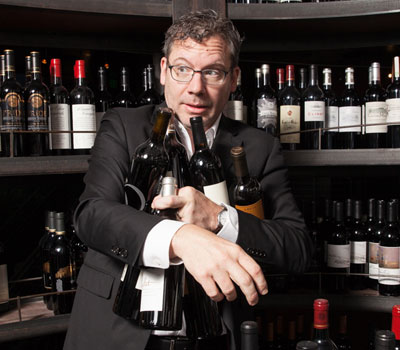There were only 80 wineries in Washington state when Seattle’s Chris Horn first got into wine in the late 1990s. Now, there are more than 940 and Horn, the director of liquids for Purple Café & Wine Bar, is responsible for sourcing a nearly 600 bottle list from them—and the rest of the world. Outside of the office, Horn is halfway through a quest to taste at least one “wine” (his quotes) from all 50 states, and asking himself: “If China is producing more wine than Germany—how come I’ve only tasted two?” Inside the office, he’s busy curating a wine playlist that goes from classic country to fusion jazz, so to speak—and wondering if merlot is about to get its second chance.


You sell a lot of rosé?
I’m super psyched that we’ve been selling a ton of rosé in the last few years. I constantly have at least three rosés by the glass—four if you count sparking rosé. That’s totally different than, say, 12 years ago when we opened. Then, you wouldn’t have a rosé in December or January because nobody would buy it. But people are drinking it and understanding that it’s not just a wine that you need to drink within a year of vintage date. And, they are understanding that there are versions that are culinary, and other versions that are very drunky time, but you can drink rosé all year round and it’s okay.
Malbec is the bestseller on your glass pour list. Are people seeking it out?
I think malbec sort of happened to be next wave of things, where you have a wine that is everywhere. I mean, I think you can swing a dead cat and hit a restaurant that has a malbec by-the-glass. A lot of them are just really easy to like. Maybe they’re not going to win any complexity awards, but they are blockbuster wines that a lot of people like to drink as a default. That’s not discounting malbec, because our malbec is made by an actual human being, not a factory. I think it’s that really safe restaurant order. You’re not going to pay a ton of money and even a mediocre malbec is going to be pleasant enough to drink. I think it’s a pretty easy thing to order, especially in a wine bar where there are 80 wines by the glass. It can be intimidating. So, give me that thing that’s familiar, that isn’t very expensive, and I’m probably going to like it.
So, let’s talk about that 80 wine by the glass list. Why 80?
Because at one time, it was 100 and that felt like little too much.
Our wine list is a couple of different things. The first thing is our wine pairing toolbox, so I need to make sure that I have different tools in that toolbox that every day when we taste with the chefs we’ll be sure to have something that is going to go with whatever they came up that day.
Also, we present wine flights and I think a lot of times it’s fun when you’re like ‘Oh I already have a northwest gewürztraminer and a northwest edelzwicker, so what other Alsatian grape can I get in here to do an Alsace inspired Northwest wine flight?’ Sometimes it’s just wanting to present a flight experience that brings in that next bottle of wine.
Why 80 wines by-the-glass? Oh what’s the analogy: You know how, when you go on a road trip and start flipping through the radio dial, you’re going to hear every single kind of music you could ever be in the mood to listen to? We want to sort of be like that for our guests. If they feel like having a glass of classic country music, I have a glass of classic country music. If they want a glass of fusion jazz, I have that too.
What wine trends are you seeing right now?
I’m constantly fascinated by trends. In college I wore a lot of baggy flannel shirts with my high-waisted jeans. It looks like some of that’s coming back, so I wonder if merlot is going to have a resurgence. Or, maybe we’ll just order it ironically like we do our tall-boy Rainiers.
There’s a lot of talk about natural wine, but it’s more like questions about natural wine because it’s a word that’s being bandied about in a marketing sense and I think it’s confusing to a lot of people. Sort of like when biodynamic started coming around and people didn’t know what it was but they thought they should be asking for it because it was special. We have a fair number of natural wines in the building, but we don’t package them and present them in that fashion. Because I don’t think that’s what makes those wines good, per se, or what makes them unique.
We’ve also had people asking for vegan wines as of late, which is borderline infuriating because if you’ve ever seen wine being made, you know there’s actually no way to make a vegan wine with the amount of insect life that’s involved. But who am I to say that that should be a rule?
What about orange wine?
I keep wishing people would ask for more skin contact and orange wines, but they don’t.
I think that’s because it’s still a widely misunderstood category and people, if they are introduced to orange wine in the wrong way, they form an impression that’s almost indelible. If you’re not consuming food when you’re drinking those wines it can be a less than pleasurable experience. But, if you’re having say a classic beef tartare with an orange wine, and it has tannins and you have that drama and those flavors, that’s when you fall in love with the stuff.
I think that people are exposing themselves to certain kinds of wines out of context, and then forming an opinion on that. They’re not wrong, they just… It’s like going to a ski resort, the middle of summer or the skiing’s going to suck. But, to go there in the middle of winter it’s beautiful. I think orange wines are like that. You have to have them at the right time at the right place or they’re misunderstood.
Accomplished forager penning a book on wild fungi and recent contributor to the October issue on pairing spirits with insect-rich cuisine, Julie H. Case brings a diverse background in writing and editing. Currently a contributor to SevenFifty Daily, Westchester Magazine and Travel & Leisure, Julie earned her BA in Broadcast Journalism at Arizona State and her MFA in Creative Writing at Pacific Lutheran University. She held senior editorial roles at several publications for the University of Washington and served as Senior Editor for SagaCity Media, where she launched several magazines, including Washington Wine, while editing the firm’s stable of local visitors’ guides.
















